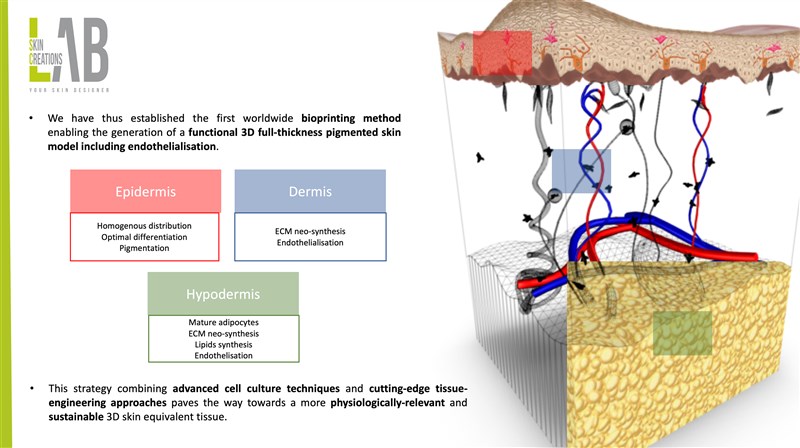2019 IFSCC CONFERENCE
LabSkin presents its Pigmented and Endotheliazed
Trilayers skin model
30/09/2019

LabSkin Creations has perfected a unique bio-ink composed of three biopolymers developed together with the hybridization of multiple bioprinting techniques and 3D printer functions.3D microextrusion-based bioprinting was used to engineer dermal and hypodermal compartments and inkject bioprinting technique to reconstruct a pigmented epidermis. This scaffold-free bioprinted constructs engineered with normal human epidermal keratinocyte and melanocyte, dermal fibroblast and adipocyte-derived stem cells (ASC) as cellular sources were cultured in optimal conditions for 42 days in total, including the ASC differentiation cell culture phase.
Histological characterisation of the 3D bioprinted three-layered skin constructs showed well organized tissue with structured and cohesive compartments. Bioprinted hypodermis displayed adipocytes cells forming droplets homogeneously distributed within the tissue. Nil red staining highlighted the formation of large lipid droplets-containing cells. Immunostaining analysis confirmed the expression of specific mature adipose tissue markers such as FABP4 and perilipin-1 on the surface of lipid droplets. The bioprinted adipose tissue was also able to release adipose tissue-specific adipocytokines and more specifically leptin and adiponectin, demonstrating the functionality of the bioprinted tissue. Additionally, the 3D bioprinted skin was morphologically and biologically representative of the normal human skin. The printed dermis presented a dense extracellular matrix with neosynthesized elastin fibres and extensive collagen deposition arranged in large organized fibres supporting the epidermal formation and proliferation to produce a full thickness, well-organized, and terminally differentiated epidermis containing melanocytes.
We have thus established the first worldwide bioprinting method enabling the generation of a functional 3D full-thickness pigmented skin model. Based on this approach, we increased complexity of incorporating a viable adipose layer providing cell-cell interactions, such as those mediated by paracrine-acting factors that may improve the physiological relevance of skin equivalents to enable them to more closely mimic features of human skin. This model may be a relevant tool to explore molecular mechanisms underlying cutaneous layers cross-talks and to identify dermo-cosmetic active compounds. More importantly, this strategy combining advanced cell culture techniques and cutting-edge tissue-engineering approaches paves the way towards a more physiologically-relevant and sustainable 3D skin equivalent tissue.
Learn More






